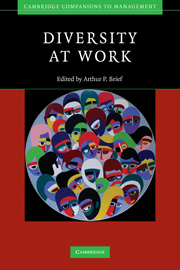Book contents
- Frontmatter
- Contents
- List of figures
- List of tables
- List of contributors
- Foreword
- Preface
- 1 Introduction: Where the sweet spot is: Studying diversity in organizations
- Part I Conceptual foundations
- Part II Emerging theoretical approaches
- 4 Identity negotiation processes amidst diversity
- 5 Diversity, conflict, and their consequences
- 6 Shifting frames in team-diversity research: From difference to relationships
- 7 Putting your own down: How members of disadvantaged groups unwittingly perpetuate or exacerbate their disadvantage
- Part III Moving ahead: Agendas for practice and research
- Index
- References
6 - Shifting frames in team-diversity research: From difference to relationships
Published online by Cambridge University Press: 19 May 2010
- Frontmatter
- Contents
- List of figures
- List of tables
- List of contributors
- Foreword
- Preface
- 1 Introduction: Where the sweet spot is: Studying diversity in organizations
- Part I Conceptual foundations
- Part II Emerging theoretical approaches
- 4 Identity negotiation processes amidst diversity
- 5 Diversity, conflict, and their consequences
- 6 Shifting frames in team-diversity research: From difference to relationships
- 7 Putting your own down: How members of disadvantaged groups unwittingly perpetuate or exacerbate their disadvantage
- Part III Moving ahead: Agendas for practice and research
- Index
- References
Summary
Shifting frames in team-diversity research: From difference to relationships
Organizational research on cultural diversity in teams has tended to focus both theoretically and empirically on differences. In this research stream, diversity is typically defined as the degree of heterogeneity among team members on specified demographic dimensions; theory aims to explain how such heterogeneity affects team processes and performance (for review, see Williams and O'Reilly, 1998). An assumption underlying much of this research has been that difference per se is a source of conflict and hence that teams must minimize members' experience of different-ness from others so as to mitigate diversity's negative effects (Chatman et al., 1998; Dovidio, Kawakami, and Gaertner, 2000; Jehn, Northcraft, and Neale, 1999).
In this chapter, we reframe diversity research from a paradigm that emphasizes difference to one that emphasizes relationships. In our approach, while difference remains a defining feature of diversity, it is no longer the principle feature. Rather, our relational approach highlights the personal, interpersonal, and intergroup dynamics that influence how people interpret and act on their differences. From this perspective, difference can also be a source of creativity and resilience. This reframing has implications for how scholars conceptualize and measure diversity and for how they theorize about the conditions that influence whether diversity becomes an asset or a liability.
We define cultural diversity as differences among team members in race, ethnicity, gender, religion, nationality, or other dimensions of social identity that are marked by a history of intergroup prejudice, discrimination, or oppression.
- Type
- Chapter
- Information
- Diversity at Work , pp. 175 - 201Publisher: Cambridge University PressPrint publication year: 2008
References
- 19
- Cited by



